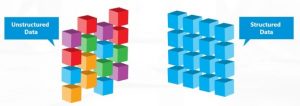 Click to learn more about author Ibrahim Surani.
Click to learn more about author Ibrahim Surani.
A lot has been said about the enormous value that businesses can derive from their information assets. However, when it comes to weighing the benefits and challenges associated with leveraging big data, it is easy to overlook a key underlying issue: More than 80% of all data collected by businesses does not reside in a standard relational database. Instead, it is trapped in unstructured documents, social media posts, machine logs, etc.
Unstructured data presents both an opportunity and a challenge to businesses. Extracting information from PDF and scanned documents, converting unstructured information into a machine readable format, combining structured and unstructured data, and ensuring data quality are a few roadblocks businesses face when it comes to making sense of unstructured data. On the other hand, the solution to identifying unpredictable, and seemingly irrational, customer behaviors and forecasting market dynamics lies in analyzing unstructured data.
Driving Business Value from Unstructured Data
Mining insights from unstructured data is not just about extracting information and integrating it with relational databases. Instead, having a vital use case and creating a strategy for integrating unstructured and structured data sources is imperative to leverage data as a key strategic asset.
Here is a step-by-step process of how businesses can transform unwieldy information into a business opportunity:
1. Identifying a Use Case
Identifying the problem you are trying to solve is the first step of any successful data-driven initiative. This might be identifying the root cause of decreasing employee productivity or optimizing the sales process. Instead of mining information from terabytes of emails, call records, and documents, identify the information exchanges that are likely to contain key data about the sales process or employees’ performance.
2. Mining Value from Unstructured Data
Just having access to relevant unstructured data is not enough. Enterprises must have the ability to extract data trapped within emails, customer calls, scanned documents, spreadsheets, and other types of unstructured sources. To achieve this, businesses need a data extraction tool with optical character recognition (OCR) and report mining capabilities that can automatically identify and extract meaningful information for faster decision-making.
3. Using Structured and Unstructured Data in Unison
It is possible to make sense of unstructured data and draw conclusions only when it is integrated with structured data sources. For example, to gain insight into the sales process, invoices, purchase orders, and other operational documents need to be tied to product, customer, and supplier data.
There are certainly tools that provide efficient report mining, text parsing, and OCR capabilities, the challenge, however, remains in integrating unstructured data with existing information systems.
To get their head around unstructured data and use it to validate assumptions and support decision-making, businesses need a tool that can improve and automate their ability to extract unstructured data, as well as integrate it with databases, enterprise applications, and visualization tools. Finding an ideal data extraction solution may require some time and effort, but it will allow businesses to consolidate structured and unstructured data and give it a clear purpose beyond marketing and IT, for a more customer-focused approach across the organization.
Image Credit: Astera Software
